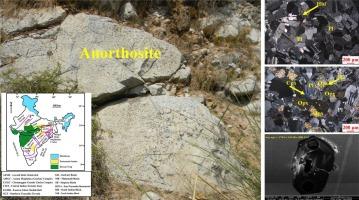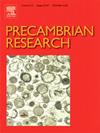东印度盾区Chotanagpur花岗片麻岩杂岩(CGGC) Barabar山斜长辉长岩组合岩石成因及U-Pb锆石年龄
IF 3.2
2区 地球科学
Q2 GEOSCIENCES, MULTIDISCIPLINARY
引用次数: 0
摘要
块状斜长岩体是元古代幔壳相互作用、地壳增生和改造过程的重要档案。这些体积庞大、斜长石为主的堆积体主要在斯塔瑟利亚-托尼亚时期(1.8-0.9 Ga)就位,并在时间上与哥伦比亚和罗丁尼亚超大陆的合并有关。尽管它们在有限的时间间隔内广泛出现,但块状斜长岩的成因仍然存在争议。与之竞争的模型援引了上涌的地幔熔体、下地壳的部分熔融和/或与俯冲有关的弧环境中的岩浆作用的推导。它们神秘的起源和时间限制突出了它们在解析元古代构造-岩浆演化中的重要意义。位于印度比哈尔邦Chotanagpur花岗片麻岩杂岩(CGGC)北部的Barabar Hill斜长岩-辉长岩组合代表了一种以前未被记录的古元古代斜长岩岩浆活动,它为斜长岩的成因和东印度盾的整体地壳演化提供了新的线索。本研究结合野外观测、岩石学、大块岩石主要元素和微量元素地球化学、矿物化学和U-Pb锆石年代学,对Barabar Hill斜长岩-辉长岩组合的(1)来源、(2)母体熔融成分、(3)地壳污染的作用(如果有的话)以及(4)侵位年龄进行了限定。热气压计算表明,辉长岩中的斜辉石在1100 ~ 1175℃和0.04 ~ 2.30 kbar条件下结晶,斜长岩中的锆石在600 ~ 765℃条件下结晶。平衡分布法(EDM)将斜长岩的母熔体成分限制在TMF = 0 ~ 20%,辉长岩的母熔体成分限制在TMF = 15 ~ 30%。同化-分数结晶(AFC)模型表明,斜长岩的来源是枯竭的地幔,上层地壳物质的贡献很大。U-Pb锆石年代学将巴拉巴尔山套的侵位年龄限定在1760.8±7.3 ~ 1762.0±3.8 Ma(斯塔西期),代表了东印度盾古元古代斜长岩岩浆活动的首次记录。巴拉巴山斜长岩与太古宙巨晶岩和元古代块状斜长岩不同,是一个具有全球意义的俯冲相关岩浆作用的典型。研究结果表明,斜长岩体是由上地壳花岗质物质污染的贫化地幔的玄武岩岩浆形成的。斜长岩的混合幔壳起源扩展了我们目前对元古代地壳演化的理解。本文章由计算机程序翻译,如有差异,请以英文原文为准。

Petrogenesis and U-Pb zircon age of the Anorthosite-Gabbronorite association near Barabar Hill, Chotanagpur Granite Gneiss Complex (CGGC), eastern Indian shield
Massif-type anorthosite intrusions represent critical archives of Proterozoic mantle-crust interactions, crustal accretion and reworking processes. These voluminous, plagioclase-dominated cumulates were emplaced predominantly during the Statherian-Tonian period (1.8–0.9 Ga), and temporally associated with the assembly of Columbia and Rodinia supercontinents. Despite their widespread occurrences during the restricted time interval, the petrogenesis of massif-type anorthosite remains contentious. Competing models invoke derivation from upwelling mantle melts, partial melting of lower crust and/or magmatism within subduction-related arc settings. Their enigmatic origin and temporal confinement highlight their significance in deciphering Proterozoic tectono-magmatic evolution. The Barabar Hill anorthosite-gabbronorite association, located in the northern Chotanagpur Granite Gneissic Complex (CGGC) of Bihar (India), represents a previously undocumented Paleoproterozoic anorthosite magmatism that sheds new light on the genesis of anorthosites and the overall crustal evolution of the eastern Indian Shield. This study integrates field observations, petrography, bulk-rock major and trace element geochemistry, mineral chemistry, and U–Pb zircon geochronology to constrain the (1) source, (2) parental melt composition, (3) role of crustal contamination, if any, and (4) emplacement age of the Barabar Hill anorthosite − gabbronorite association. Thermobarometric calculations suggest that clinopyroxenes in the gabbronorites crystallized at 1100–1175 °C and 0.04–2.30 kbar, and zircons in the anorthosites crystallized at 600–765 °C under FMQ buffer conditions. Equilibrium Distribution Method (EDM) constrain parental melt compositions at TMF = 0–20 % for the anorthosites and 15–30 % for the gabbronorites. Assimilation–Fractional Crystallization (AFC) modelling suggests derivation of the anorthosites from a depleted mantle source with significant contributions from upper crustal materials.
U-Pb zircon geochronology constrains the emplacement age of the Barabar Hill suite to 1760.8 ± 7.3 to 1762.0 ± 3.8 Ma (Statherian period), thus representing the first record of Paleoproterozoic anorthosite magmatism in the eastern Indian Shield. The Barabar Hill anorthosite represents a globally significant example of subduction-related magmatism, distinct from Archean megacrystic and Proterozoic massif-type anorthosites. The findings of this study suggests that anorthosites massifs were formed from basaltic magmas derived from the depleted mantle which was contaminated by upper crustal granitic materials. A hybrid mantle-crust origin for anorthosites expand our current understanding of Proterozoic crustal evolution.
求助全文
通过发布文献求助,成功后即可免费获取论文全文。
去求助
来源期刊

Precambrian Research
地学-地球科学综合
CiteScore
7.20
自引率
28.90%
发文量
325
审稿时长
12 months
期刊介绍:
Precambrian Research publishes studies on all aspects of the early stages of the composition, structure and evolution of the Earth and its planetary neighbours. With a focus on process-oriented and comparative studies, it covers, but is not restricted to, subjects such as:
(1) Chemical, biological, biochemical and cosmochemical evolution; the origin of life; the evolution of the oceans and atmosphere; the early fossil record; palaeobiology;
(2) Geochronology and isotope and elemental geochemistry;
(3) Precambrian mineral deposits;
(4) Geophysical aspects of the early Earth and Precambrian terrains;
(5) Nature, formation and evolution of the Precambrian lithosphere and mantle including magmatic, depositional, metamorphic and tectonic processes.
In addition, the editors particularly welcome integrated process-oriented studies that involve a combination of the above fields and comparative studies that demonstrate the effect of Precambrian evolution on Phanerozoic earth system processes.
Regional and localised studies of Precambrian phenomena are considered appropriate only when the detail and quality allow illustration of a wider process, or when significant gaps in basic knowledge of a particular area can be filled.
 求助内容:
求助内容: 应助结果提醒方式:
应助结果提醒方式:


